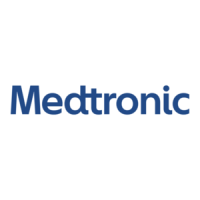Do you have a question about the Medtronic DBS and is the answer not in the manual?
Contraindicated for patients exposed to diathermy due to risk of tissue damage.
Contraindicated for specific DBS systems due to risk of tissue heating and severe injury.
Contraindicated for patients unable to operate control or charging devices without assistance.
Contraindicated for patients with an implanted DBS System.
Risk of brain tissue damage from high amplitude and wide pulse width settings.
Rupture or piercing of neurostimulator case can cause severe burns from battery chemicals.
Extreme care needed during lead implantation in patients at heightened risk of intracranial hemorrhage.
Field generated by equipment that can disrupt neurostimulator function, causing injury or system damage.
Discuss possible interactions between neurostimulator and cardiac devices before surgery.
Implanting and prescribing physicians need specific experience and knowledge of DBS procedures.
Decision to turn off neurostimulator for procedures needs careful consideration and consultation.
Guidelines for component packaging, sterilization, and storage temperatures.
Guidelines for selecting compatible Medtronic or non-Medtronic components for implant or replacement.
Patients with partially explanted systems remain susceptible to EMI effects.
Evaluate MRI scan eligibility when selecting replacement components, considering extension type.
The system may unexpectedly cease to function due to various events.
Implantable components must be handled with extreme care to avoid damage.
Proper routing of lead-extensions minimizes EMI potential.
Guidelines for selecting an optimal location for the neurostimulator.
Specific considerations for replacing or using these neurostimulator models.
Specific considerations for the Activa RC neurostimulator.
Do not use the recharger on an unhealed wound due to sterility issues.
Advise patients to charge regularly to prevent battery discharge and overdischarge.
DBS system may affect operation of other implanted devices like pacemakers.
Lower amplitude to 0.0 V before connecting/disconnecting cables or replacing batteries.
Advise patients on risks, benefits, and reading the patient manual.
Factors like caregiver support, age, mental/physical ability, and visual acuity are important.
Group selection, interaction with other devices, device handling, use, and recharger use.
Activities requiring coordination, excessive twisting/stretching, and component manipulation.
Ensure neurostimulator is programmed to 'Off' before ECG to avoid inaccurate results.
Keep RF devices at least 10 cm (4 in) away to prevent unintended stimulation changes.
Potential risks including intracranial hemorrhage, anesthesia complications, and procedure-related issues.
Potential risks including delayed hemorrhage, site complications, infection, and neurological symptoms.
Describes three types of EMI: conductive current, induced/coupled current, and radiated energy.
Safety not established for use with implanted DBS systems.
Safety not established; external defibrillation may damage system or cause tissue damage.
Safety not established; induced currents may cause heating and tissue damage.
Safety not established for recording procedures using EMI-generating equipment.
Place TENS electrodes to avoid passing current over system components.
Magnets can cause inadvertent on/off activation of neurostimulator; advise patients not to use them.
Advise patients to approach security devices with caution as they can turn neurostimulator on/off.
No electrical interference issues, but transducer should not be placed directly over the implant.
Use of high-output ultrasonic devices is not recommended due to potential damage to neurostimulator circuitry.
| Manufacturer | Medtronic |
|---|---|
| Device Type | Deep Brain Stimulation System |
| Intended Use | Treatment of movement disorders such as Parkinson's disease, essential tremor, and dystonia |
| Components | Pulse generator, leads, extensions, and programmer |
| Battery Life | Varies by model and usage, typically 3-5 years for non-rechargeable, up to 9 years for rechargeable |
| Indication | Parkinson's disease, essential tremor, dystonia |
| Target Brain Region | Subthalamic nucleus (STN), globus pallidus internus (GPi), thalamus (Vim) |
| Pulse Generator Type | Rechargeable and non-rechargeable options available. |
| MRI Compatibility | Conditional, specific models may be MRI-compatible under certain conditions |
| Lead Configuration | Quadripolar or octopolar leads |












